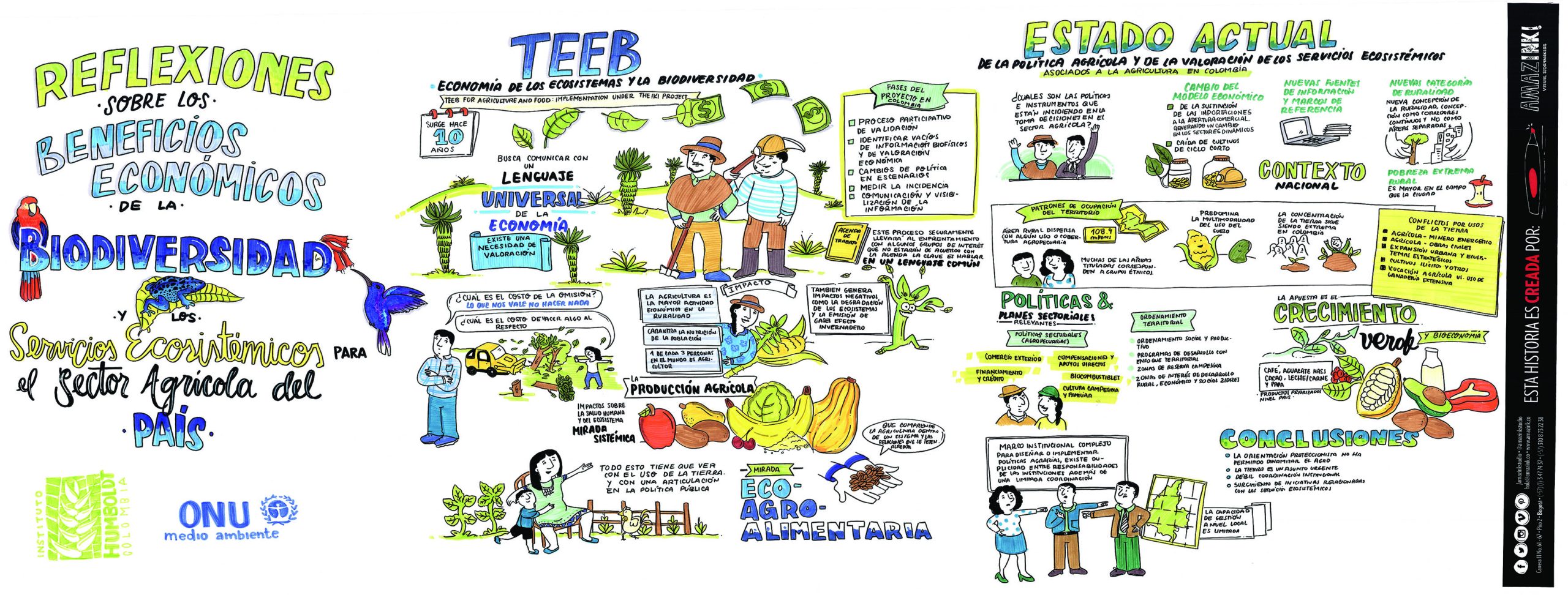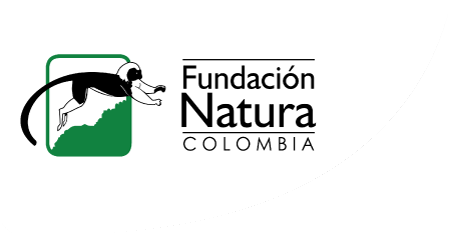Latest updates
- [May 2022] Stakeholder consultations and events were held to validate key messages and policy recommendations, based on scenario analysis of bioeconomy development policies in the Amazon region (with focus on palms native to the Amazon).
- [November 2021] A TEEBAgriFood Colombia public forum (event recording; +900 views) aimed at promoting a high-level policy dialogue as well as sharing lessons learned from Colombia on applying the TEEBAgriFood application framework. The case was presented for nature positive agriculture not only being good for the environment, but also for livelihoods.
- [March 2021] Cross-sectoral actors have been brought together by the Humboldt Institute to prioritize and evaluate different future policy pathways that promote a shift towards nature-positive land management, both at the national level as well as at subnational level in the Putumayo department.
- [May 2020] Adequately recovering from the impacts of Covid-19 largely depends on the identification of sustainable and viable livelihood options. In response, a new workstream was developed to apply the TEEBAgriFood Evaluation Framework to assess bioeconomic development scenarios for the Amazon region.
- [April 2020] In collaboration with the Humboldt Institute, field missions were organized to the Putumayo Department to identify policy priorities with municipal and regional government actors, as well as to gather data on ecosystem services (with particular attention to the values of local and indigenous communities).
Scope of work
1. Land-use planning (Putumayo)
UNEP supported the Humboldt Institute – the scientific arm of the National Environmental System – to institutionalize comprehensive food systems evaluations into national and subnational decision-making processes.
Agriculture and food system decision making is often based on farm level data, delivering an incomplete and biased picture of impacts. In response, UNEP has built capacity to develop predictive models that incorporate landscape interactions among socio-economic and environmental drivers, sectors, policies and land-cover impacts. This allowed the integration of the high heterogeneity of the landscape in policy recommendations for promoting a shift towards nature-positive land management, both at the national level as well as at subnational level in the Putumayo department – a biodiversity hotspot with relevance in terms of indigenous land.
Cross-sectoral actors have been brought together at the national and subnational level to prioritize different future policy pathways for assessment : i) good agricultural practices, ii) better technology at stages of the agricultural value chain, iii) better construction and road infrastructure, iv) Incentives for product transformation, v) Incentives for restoration, vi) conservation incentives, and vii) strengthening of indigenous practices. Those scenarios were assessed on their changes in the provisioning of a wide range of ecosystem services: food, water supply, carbon regulation service, erosion control, water regulation, pollination, habitat services, cultural services (nature tourism)
2. Developing biodiversity centered value chains and a bioeconomy strategy for the Amazon region
Adequately recovering from the impacts of Covid-19 largely depends on the identification of sustainable and viable livelihood options. The bioeconomy has the potential to address multiple objectives: livelihoods, health, education and food security, while protecting biodiversity and ecosystem services.
The Amazon region of Colombia, with its high biodiversity, presents a wide range of options with bioeconomic potential such as fruits, fiber and essential oils, amongst others. One of the most frequent and abundant botanical families are the native palm species, with various potential uses (food, cosmetic and pharmaceutical) and multiple opportunities for transformation and added value.
In collaboration with Fundación Natura, The TEEBAgriFood Evaluation Framework was applied to the following bioeconomy development scenarios in the Amazon region (with focus on palms native to the Amazon):
- What would happen if less sustainable livelihood options, focused on short term economic recovery, persist?
- What would happen if we developed native palm value chains without an integrated vision of the bioeconomy (ie. not including social component)
- What would happen if we only focused on biodiversity conservation efforts?
The evidence generated through this scenario analysis showed the need for an integrated vision on the bioeconomy, including an environmental, social and economic component).
Publications and resources
Synthesis report and factsheet: Land-use Planning (Putumayo region) - forthcoming
Synthesis report and factsheet: bioeconomy and palms native to the Amazon region - forthcoming
Interim reports for land-use planning in the Putumayo region
- Interim scenario modeling results
- Methodology report
- Evaluation Framework report
- Information baseline and gap analysis
- Scoping report
Interim reports for bioeconomy in the Amazon region
Events and meetings
#MakeNatureCount Colombia Forum (November 2021) [Recording] [Infographic panel 1; panel 2]
Bioeconomy in Amazon region
- Final Stakeholder Consultation and Results Workshop (Virtual, May 2022). [Outcome report, recording]
- TEEBAgriFood Regional Symposium (Virtual, June 2022). Bioeconomy in Amazon region Thematic session [concept note, recording]
- Exchange workshop with Bolivia on TEEBAgriFood bioeconomy in the amazon region [training material, analytical study] [April 2022]
Land-use Planning (Putumayo region)
- TEEBAgriFood Regional Symposium (Virtual, June 2022). Thematic session about integrating socio-economic and natural capital dimensions in landscape level modeling [concept note, PPT, recording 1:03]
- International TEEBAgriFood exchange with Colombia [Spanish] [English audio] (April 2021)
- Scenario validation workshop [report] (March 2021)
- Scenarios development workshops [national] [subnational] (February 2021)
- Model Validation and capacity-building workshop [Report] (March 2020)
- First consultation workshops local communities [Report] (Q1 2020)
- TEEBAgriFood Global Symposium (Nairobi, February 2019)
- 1st national workshop (Bogotá, December 2017)

For TEEB website_Dia1ReflexionesBeneficioEconomico (1)
Status: Ongoing
This project is funded by the International Climate Initiative (IKI) of the German Federal Environment Ministry.
Host Ministry:
 Ministry of Environment and Sustainable Development
Ministry of Environment and Sustainable Development
Research institution:

Alexander von Humboldt Biological Resources Research Institute
Other partners
- Earth Innovation Institute Colombia
- Federación orgánicos de Colombia
- Food and Agriculture Organization of the UN (FAO)
- GIZ Colombia
- Ministry of Agriculture and Rural Development
- Pontificia Universidad Javeriana
- Rural Agricultural Planning Unit (UPRA)
- Sociedad de Agricultores de Colombia (SAC)
- Territorial Renewal Agency
- UNEP Colombia
- WWF Colombia


